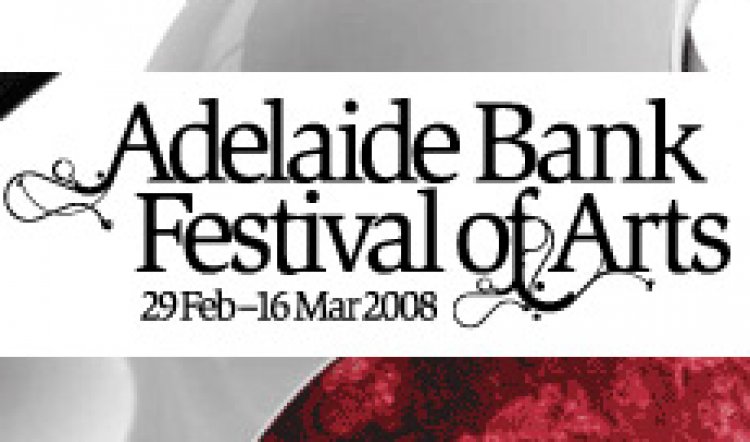
Adelaide Bank Festival of Arts 2008
The first thing you notice, driving into Adelaide for the first time since the last Festival, is that it doesn't appear to have rained since then. The second thing you notice is that Adelaideans have not let that get them down. Although the parklands are brown and dusty, the city looks good, the atmosphere is buzzing, and things have been happening.
Two years ago they were talking about infrastructure, public transport and so on. Now, there are smart new trams running on shiny new lines up and down North Terrace and around the city and, quite literally, going places. Coming in from Sydney where infrastructure in general and public transport in particular is a sick joke out-done only by the reeking sick joke that is the NSW state government, it's astounding to see.
And this year's festival program is also an eye-opener. While the Sydney Festival of January has just closed off its books with a gung-ho report of higher ticket sales and more revenue than the year before, a quick browse through the Adelaide program highlights how lopsided and peculiar was the Sydney program.
Opening the shindig with a bang and something to get people talking is Festivals 101 and Brett Sheehy began his last program for Adelaide (before he moves on to Melbourne) with a production that tells you a lot about his confidence and grown-upness these days: the Australian premiere of Osvaldo Golijov's Ainadamar.
For the past few years it has become apparent that Golijov is the new black of opera and orchestral music, and to commission a production, from scratch, is a tip of the hat from the outgoing director to the city and its festival: he knows what the Adelaide Festival is about and what its customers expect: sophistication, something new and something highbrow.
Ainadamar is all of those things and more. With a libretto by American playwright David Henry Hwang and directed by Graeme Murphy, the 75-minute "opera in three images" is a beautiful, visually spectacular, thoughtful and moving evocation of the art and life of Federico Garcia Lorca as seen through the eyes of Margarita Xirgu.>
Xirgu, we learn, has made a career - in exile in South America - playing Mariana Pineda in Lorca's play of the same title. At the time of the Spanish civil war she left the country and he went home to Granada for one last visit. He was murdered by the fascists in 1936 along with many thousands of others in the city and elsewhere and when Franco's forces triumphed, Spain became a sullen, fear-steeped backwater for more than 30 years.
Much of this is tangible and obvious in Ainadamar (fountain of tears) and much more besides. The set, by Brian Thomson, features possibly the only free-running cascade of water in Adelaide at the moment (many public fountains and water features are dry) and there is an audible response from the audience when it begins falling in a silver, plashing curtain at the rear of an otherwise dark abyss of stage.
Water encapsulates everything that is beautiful and extraordinary about Granada, the ancient city of Moorish Spain. Because water, rather than gold, silk or spices, was the Moors' symbol of their wealth and intellectual superiority. It was so simple: in the harsh, thirsty south of Spain - a region that resembles north Africa more than Europe - the city and its Alhambra palace demonstrated to Catholic Spain and the rest of Europe its affluence and intellectual brilliance through its lavish use of water. Everywhere you turn fountains, cascades, streams and pools are sparkling and shimmering in the sun. Coming in from the dour north, or the parched landscape of rural Andalucia, Granada is a magnetic, irresistible city of dreams.
And so it was for Lorca: he had to go back, no matter what danger lay in store; and the fountain of tears, both figurative and literal, was the only possible destination. In his production, Graeme Murphy has picked up on the fragmentary flamenco motifs in Golijov's music and through them brought a characteristic (for him) if unusual (for opera) dance element to the production. The chorus of village or gypsy women (members of the Adelaide Vocal Project) not only keen and wail the Mariana Pineda theme, but move as would such a group at a fiesta: stamping, swirling, heads held arrogantly high, the epitome of such women. They also fulfill the role of the classic chorus: observing, commenting on the action and taking it forward through story-telling.
The story is of Margarita's dying lament as she thinks back over her long life to the time when she and Lorca were young, passionate democrats, opposing the forces of Franco and fascism. Through the years she has kept alive his spirit through his work, but now, as her own death approaches, she is filled with sadness and memories. She relives those times, when the young poet, who loved, art, life and Spain but was condemned as "a faggot", was her adored companion. Listening and comforting her is a young actress, Nuria, who will take over her roles when she is gone. Appearing, dreamlike, to Margarita and Lorca, is a wraithlike creature, the Spirit of Mariana Pineda and the Voice of the Fountain. She is with both when they die and leads them into the Fountain: through the curtain of sweet water to ... well, who knows, probably a place where the word drought is unknown.
The Australian production is blessed with the presence in the leading roles of the two singers who created them at Tanglewood in 2003: Jessica Rivera as the dying Margarita and Kelley O'Connor at Lorca. O'Connor has an electrifying voice which goes way beyond the description of "mezzo-soprano" into deepest contralto territory. With her dark hair pulled severely back and dressed in workmanlike overalls, she is beautiful and androgynous. The rustle of surprise in the audience was predictable: is it a girl? is it a boy? Is it one of those male sopranos? But no, O'Connor is one of those rare singers who is not only comfortable in a very low range (a clear and bell-like tone, with no strain whatsoever) but is also comfortable in using it to portray a young man. Her ease in the role is obvious and makes Lorca a properly compelling and attractive human being.

There is a curious frisson (forbidden fruit? the other?) to the relationships portrayed in operas where the male lead is a "trouser role" for a female singer. It's lost or weirdly altered when those roles are taken by male sopranos: it is difficult not to feel that the heroine is rather foolishly in love with a queen and he will break her heart in the end anyway, no matter what the libretto demands. (And whether or not the singer is gay in real life!) Do heterosexual women feel the same way about watching a female-male lead? Possibly not: could it be that women are accustomed to relying on women friends in a way they would never dream of relying on a male partner.
Whatever: when the older Margarita yearns for the companion of her youth, there is an exquisite sweetness and courage in the way the two relate, on both a personal and political level. "When our voices are silent we disappear," is an observation made by Margarita that is as true nowadays as it was in the 1930s.
In the small role of Nuria, Leanne Kenneally also enters into the spirit of the piece and her work in the trios and in a moving and unusual quartet which includes the Spirit (former Sydney Dance Company dancer Jan Pinkerton) is just breathtaking. The only let-down in an otherwise sensitive, imaginative and altogether handsome production is, ironically, the re-enactment of Lorca's death.
For a start, it is one of the more protracted death scenes in an art form which is notorious for forcing the karkee to sing at least one aria if not two before expiring. And then, the director seems at a loss for things that Lorca might do while awaiting the tardy fatal bullet, other than whingeing and become progressively weepier. And that's rather unfortunate in the circumstances. Even more unfortunate is the action of the Spirit who, as Lorca finally succumbs, throws herself upon his prostrate form and spouts a mouthful of water. It's just plain silly and you know it is when members of the audience snigger when they should be snuffling into their hankies. Finally, the least said about the uncountable cartoon bullet holes and gushing red stuff on the screens at that moment, the better.
That fairly brief moment aside, Golijov's meditative, modern but referential music is easy to listen to but complex and satisfying too. Conducted by Giancarlo Guerrero, it features the Adelaide Symphony Orchestra with an augmented percussion section and the Grigoryan brothers, Slava and Leonard, on flamenco guitars.
Brian Thomson's set is simple and effective: three large, tall, freestanding curved elements on which are back-projected video images (Tim Gruchy, fabulous) and moved around and off-stage by the performers. Damien Cooper is the lighting designer and, as usual, one can see why his is the number on the speed-dial when tricky, imaginative and spectacular lighting effects are required. Jennifer Irwin's costumes evoke Spain of the 1930s with simplicity and economy: swirling black mid-length skirts; fringed, floral pattern wraps that the women use as capes and to dress up their otherwise dress-down outfits; an airy nothingness for the Spirit and so on.
The men are very much in the walk-on, support roles in Ainadamar, but Jamie Allen (the Arresting Officer) and Stephen Bennett (Guard) do the most with their moments in hiss-the-villain style.
Overall, Ainadamar is a terrific piece of festival programming: some like, some do not, most talk about it. It also sets the tone for the 2008 festival: serious programming, innovation and artistic daring. For those who want some serious music and opera - here it is, and it's a piece that would otherwise be an unlikely visitor to Australia and will never be programmed by a domestic company.
Essentially, Adelaide is all go. Writers Week is on at the moment of course which means publishers, agents and writers are here from all over Australia and overseas. Ian McEwan was mopping his brow in one of the tents, Lowitja O'Donoghue was spotted taking refreshment and a bit of shade at a pavement cafe; Geraldine Brooks is giving good festival in her sessions and many members of the writers' audiences, male and female, have taken to the Panama hat - the real thing - while the parasol is to be seen bobbing about too.
Tonight: Midsummer Night's Dream in a number of Indian languages and the South Australian answer to Keating! in a show about Don Dunstan. Watch this space: in all senses of the word: Adelaide is HOT!



